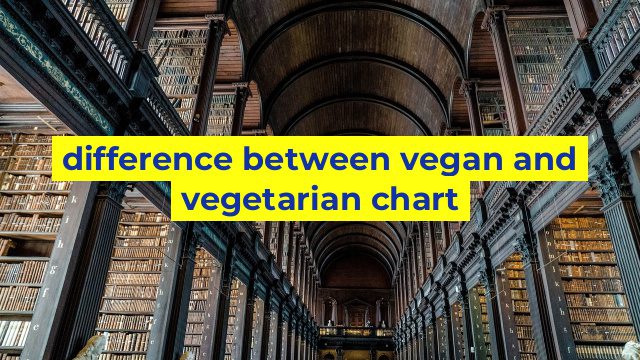The Difference Between Vegan and Vegetarian Diets – A Comprehensive Comparison Chart
The world is becoming more health-conscious, and as people begin to pay more attention to their diet, the question of what to eat becomes more pertinent. The terms “vegan” and “vegetarian” are often used interchangeably, leading to confusion about what each diet requires. This article aims to clear up the differences between the two by providing a comprehensive comparison chart.
What Does a Vegan Diet Entail?
A vegan diet is free from all animal products, including meat, fish, dairy products, and eggs. Vegans also avoid using products derived from animals, such as leather, fur, and silk. The primary focus of a vegan diet is to minimize harm to animals and the environment.
What Does a Vegetarian Diet Entail?
A vegetarian diet excludes meat, fish, and poultry, but still includes dairy products and eggs. Vegetarians may still consume animal products and byproducts, such as gelatin, honey, and cheese. The primary focus of a vegetarian diet is to minimize harm to animals.
Comparison Chart
| Aspect | Vegan | Vegetarian |
|---|---|---|
| Animal Products | Absolutely excluded | Excludes meat, fish, and poultry, but includes dairy products and eggs |
| Focus | Minimizing harm to animals and the environment | Minimizing harm to animals |
| Health Benefits | Can reduce the risk of heart disease, diabetes, and some cancers | Can reduce the risk of heart disease, type 2 diabetes, and some cancers |
| Challenges | Veganism can require careful planning to ensure adequate intake of certain nutrients such as protein, calcium, and vitamin B12 | Vegetarians may struggle to consume an adequate amount of protein if not consuming animal products, and may also struggle to consume adequate calcium |
| Environmental Impact | Often seen as a more eco-friendly choice due to the reduction in animal agriculture impact on greenhouse gas emissions, water and land usage | Still seen as a positive environmental choice for similar reasons but will have more impacts as the diet includes animal products |
| Availability of Foods | The rise in the vegan market is increasing the accessibility of vegan alternatives but still may struggle to find variety of foods when dining out | Vegetarianism is much more common than veganism, so it tends to have a broader range of options available both for cooking at home and dining out |
Conclusion
Choosing between a vegan and vegetarian diet ultimately comes down to personal preference and your personal values. No one diet is superior, and both are associated with many health benefits. Regardless of which diet you choose, be sure to plan your meals carefully to ensure that you get all the nutrients your body needs.
Table difference between vegan and vegetarian chart
| Vegan | Vegetarian | |
|---|---|---|
| Dietary Restrictions | Excludes all animal products and byproducts, including meat, dairy, eggs, honey, and gelatin. | Excludes meat products but may include dairy, eggs, and honey. |
| Environmental Impact | Generally considered to have a lower carbon footprint due to reduced consumption of animal products. | Can still have a significant environmental impact if a lot of animal products are consumed. |
| Health Benefits | May have lower risk of heart disease, cancer, and other health conditions due to a diet rich in plant-based foods. | May still have health benefits if a diet rich in whole foods and low in processed foods and animal products is followed. |
| Animal Welfare | Advocates for animal welfare and seeks to reduce animal suffering by not consuming or using animal products. | May still use animal products such as dairy and eggs, but may choose to support humane and ethical farming practices. |
| Food Choices | May require more planning and preparation to ensure all nutritional needs are met while excluding animal products. | May have a wider variety of food choices available, but still need to ensure a balanced and healthy diet. |


